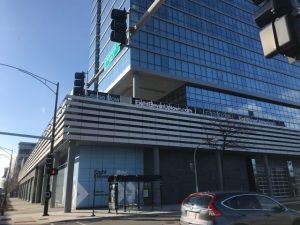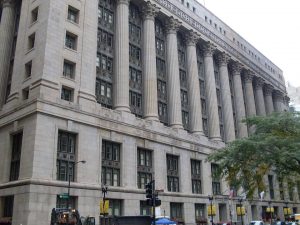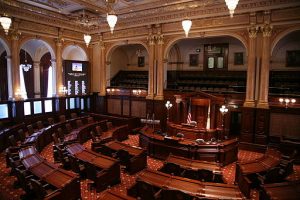Hours before the Cook County Board of Commissioners rejected a partial rollback of a controversial sales tax increase, concerned citizens stood outside the crowded meeting room, frustrated they couldn’t see first hand what was happening inside.
More than two dozen people waited in line in the county building, some for as long as two hours, to enter the Sept. 1 board meeting where the county commissioners, in a surprise decision, failed by one vote to override Board President Todd Stroger’s veto.
The 13-4 decision upholds the tax at its current rate of 1.75 percent instead of reducing it to 1.25 percent. It’s estimated the county would have lost more than $2 million by dropping the rate .5 percent.
Cynthia Schilsky, president of the Cook County League of Women Voters, traveled from southwest suburban La Grange to attend the meeting and didn’t like being stuck on the sidelines.
“I’m aggravated. I think people should be able to get in. I understand it is not a big room, but they should make it available to those who are here to be seen,” Schilsky said.
State Rep. John Fritchey, (D-Chicago), who moments before Tuesday’s meeing officially announced his plans to replace retiring Cook County Commissioner Forrest Claypool, said it is important for the public to be included in meetings.
“I’m sure there are a lot of elected officials that would prefer the public not seeing what they do,” Fritchey said. “I feel that being open to the public is a pretty fundamental notion of being a public body, especially given that we’ve got the cost efficient technology these days to do this instantly.”
Schilsky said the Cook County League of Women Voters made suggestions to the board about preparing overflow rooms and streaming video for those who cannot get in.
“When we have suggested it, it’s always the money issue,” said Schilsky.
The public can watch the meetings if they have access to Comcast cable channel 900.
Dick Simpson, head of the political science department at University of Illinois at Chicago and a former Chicago alderman, said it is important to open up the county board to better cable and Web castings along with making overflow rooms available.
“There ought to be a separate room set up for overflow crowds, or they could have asked to move to the larger city council chambers,” Simpson said.
The Chicago Board of Education uses overflow rooms and streaming video for its meetings.
Chicago Public Schools Spokesman Malon Edwards said when people come to the board meetings, they are given a seating pass. When there are no more passes available, overflow rooms are opened with streaming video of the board meeting.
The board of eduction meeting room holds about 115 people, while the overflow room can seat an additional 85.
Edwards said it also use a rotation that keeps a constant flow of people between the board and overflow rooms.
“We get people in and out as quickly as we can. Looking at the logistics of it, it looks to be a very smooth process,” Edwards said. “It looks to be a good alternative to sitting in the chamber.”

![Reblog this post [with Zemanta]](http://img.zemanta.com/reblog_e.png?x-id=0f00f32c-4c47-4e69-a93e-000bee098447)










Be First to Comment